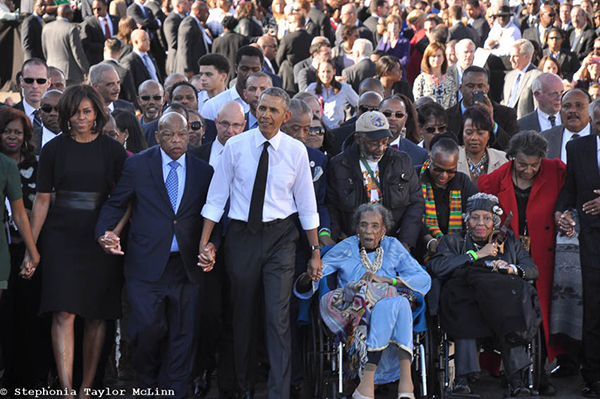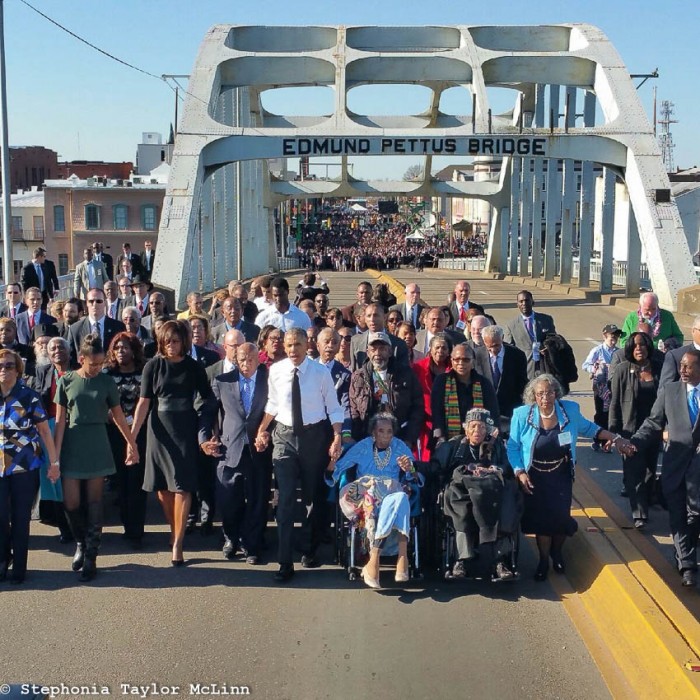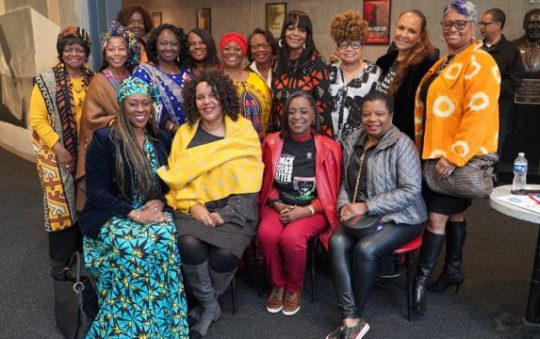
WASHINGTON (NNPA) – Amelia Boynton Robinson, who died Wednesday in Montgomery, Ala. at the age of 104, is being praised as the ‘Rosa Parks’ of the Selma voting rights movement.
Mrs. Boynton, as she was known throughout the movement, had been hospitalized since suffering a stroke in July. She was a courageous voting rights crusader who was brutally beaten on “Bloody Sunday” on the Edmund Pettus Bridge, the first leg of the Selma to Montgomery, Ala. March that provided the impetus for passage of the landmark Voting Rights Act of 1965, which was signed into law by President Lyndon B. Johnson.
She and her late husband, Sam Boynton, opened their home to Atlanta-based voting rights organizers representing the Student Nonviolent Coordinating Committee (SNCC) and the Southern Christian Leadership Conference (SCLC). Dr. Martin Luther King, Jr. also conducted many of his strategy sessions in the Boynton home.

“Dr. Boynton was the straw that stirred the drink. She was a major catalyst in the Selma to the Montgomery march,” said Charles Steele, Jr., president and CEO of SCLC, the organization co-founded by Dr. King. “She helped start and more importantly, bring attention to ‘Bloody Sunday’ and her strength, courage and tenacity helped make Selma the historical icon that we know today. Dr. Boynton was to Selma what Rosa Parks was to Montgomery,” a reference to the African American seamstress whose refusal to give up her seat to a White patron ignited the 1955 Montgomery, Ala. Bus Boycott that propelled King to national fame.
President Barack Obama, who was with the wheelchair-bound Boynton in March to commemorate the 50th anniversary of the Selma to Montgomery March, also praised the civil rights warrior.
“Fifty years ago, she marched in Selma, and the quiet heroism of those marchers helped pave the way for the landmark Voting Rights Act,” he said in a statement. “But for the rest of her life, she kept marching – to make sure the law was upheld, and barriers to the polls torn down. And America is so fortunate she did.”
Obama added, “To honor the legacy of an American hero like Amelia Boynton requires only that we follow her example – that all of us fight to protect everyone’s right to vote.”
Rep. John Lewis (D-Ga.), whose skull was cracked in Selma on “Bloody Sunday,” said:
“This nation has lost a crusader, a warrior, and a fighter for justice. She was one of the most dependable, reliable leaders to stand up for the right to vote in Selma, Alabama and in the American South.”
He continued, “Amelia Boynton was fearless in the face of brutal injustice, willing to risk all she had on the frontlines of change in America. She was arrested, shoved and pushed in front of the Dallas County courthouse by sheriff Jim Clark. She was knocked down on Bloody Sunday on March 7, 1965, on the Edmund Pettus Bridge as 600 of us attempted to march to Montgomery to dramatize the dire need for voting rights legislation in this country.”
Andrew Young, a former Martin Luther King lieutenant and former U.S. ambassador to the United Nations, recalled how difficult it was for Blacks to register to vote in Alabama during the 1950s and 1960s.
Writing in his memoir, An Easy Burden: The Civil Rights Movement and the Transformation of America, he said, “In 1964, no blacks were registered in Wilcox County, less than four percent in Hale County, slightly less than seven percent in Perry and Choctaw Counties, and less than three percent in Dallas County, where Selma was located.”
Young wrote that she and her husband had two spare rooms and that they made one available to him and the second was shared by Dorothy Cotton and Septima Clark when they were in town to organize Blacks.
He wrote, “Mrs. Boynton never charged us a penny in rent for the months we stayed in her home.”
It was Boynton who persuaded Dr. King to become involved in the Selma movement, which was captured in the popular movie “Selma,” directed by Ava DuVernay. Boynton was portrayed in the movie by Lorraine Toussaint.
King would often hold strategy sessions in the Boynton home.
Andrew Young wrote, “Selma was a city that had been bruised and abused long enough. Mrs. Boynton’s plea was for Dr. King to give them the push they needed to get organized and finally win the right to vote without harassment.”
Boynton was active on the frontlines of the movement.
James E. Fager, author of Selma 1965: The March That Changed The South, recounted a 1965 incident.
“Mrs. Boynton is a tall, aristocratic-looking woman, not inclined to take any guff from James Clark or his trashy policemen,” Fager wrote. “And when she didn’t move fast enough to please the sheriff, his temper flared. He grabbed her by the back of her collar and pushed her stumbling halfway down the block to a sheriff’s car, in full view of the reporter and the astonished black marchers.”
Pulitzer Prize-winning author David J. Garrow, writing in Bearing the Cross: Martin Luther King, Jr. and the Southern Christian Leadership Conference, reported that Dr. King, watching the encounter from across the street, said the incident was “one of the most brutal and unlawful acts I have ever seen an officer commit.”
It got even uglier when Boynton attempted to march across the Edmund Pettus Bridge in Selma on “Bloody Sunday.”
James Fager wrote, “Mrs. Amelia Platts Boynton, who was standing tall only a few ranks from the front a moment before, had been one of the first to fall, clubbed into unconsciousness. As she fell to the pavement, a creased plastic rainhat that someone had given her slipped down over her face. A trooper came by and dropped a tear gas canister right in front of her, and as the piercing liquid and fumes sprayed out, only the wrinkled sheet of plastic kept it from drenching her eyes and going straight into her lungs.
“Now from between nearby buildings a line of horses emerged at the gallop, their riders wearing the possemen’s irregular uniform and armed with bullwhips, ropes, and lengths of rubber tubing wrapped with barbed wire. They rode into the melee with wild rebel yells, while behind them the cheers of the spectators grew even louder. ‘Get those god-damned niggers’ came Jim Clark’s voice. ‘And get those goddamned white niggers!’”
Two photographs from that day were widely-circulated, one showing her lying on the ground with a White Alabama State Trooper standing over her with a nightstick. The other picture shows a fellow protester trying to lift her up from the ground.
Not only did the marchers complete the 54-mile journey to Montgomery, the Alabama state capital, the United States was forever changed as a result of the Selma movement.
“I am so glad she lived to see Dr. King lead a march from Selma to Montgomery, that she lived to see the Voting Rights Act signed into law, that she lived to see the amazing transformation our work gave rise to in America,” said Rep. John Lewis. “I am so glad she lived to see President Obama nominated and elected and that she was on the bridge with two Presidents and two First Ladies this year to mark the 50th anniversary of the march. At over 104 years old, Mrs. Amelia Boynton lived a well spent life helping to make Alabama and our nation a better place.”






